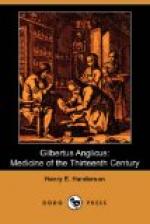Wounds of the heart, lungs, liver, stomach and diaphragm are regarded as hopelessly mortal (f. 233d), and the physician is advised to have nothing to do with them. Wounds of the heart are recognized by the profuse haemorrhage and the black color of the blood; those of the lung by the foamy character of the blood and the dyspnoea; wounds of the diaphragm occasion similar dyspnoea and are speedily fatal; those of the liver are known by the disturbance of the hepatic functions, and wounds of the stomach by the escape of its contents. Wounds of the intestine are either incurable, or at least are cured only with the utmost difficulty. Longitudinal wounds of the spine which do not penetrate the cord may be repaired, but transverse wounds involving the cord, so that the latter escapes from the wound, are rarely, if ever, cured by surgery. Wounds of the kidneys are also beyond the art of the surgeon. Wounds of the penis are curable, and if the wound is transverse and divides the nerve, they are likewise painless.
Si vene titillares in coxis abscidantur homo moritur ridendo. A passage which I can refer only to the erudition and risibility of our modern surgeons and anatomists. The ticklish vene titillares are to me entirely unknown.
Modern abdominal surgeons will probably be interested in reading Gilbert’s chapter on the treatment of wounds of the intestines in the thirteenth century. He says (f. 234c):
If some portion of the intestine has escaped from a wound of the abdomen and is cut either longitudinally or transversely, while the major portion remains uninjured; if the wound has existed for some time and the exposed intestine is cold, some living animal, like a puppy (catulus), is to be killed, split longitudinally and placed over the intestine, until the latter is warmed, vivified by the natural heat and softened. Then a small tube of alder is prepared, an inch longer than the wound of the intestine, carefully thinned down (subtilietur) and introduced into the gut through the wound and stitched in position with a very fine square-pointed needle, threaded with silk. This tube or canula should be so placed as to readily transmit the contents of the intestine, and yet form no impediment to the stitches of the wound. When this has been done, a sponge moistened in warm water and well washed should be employed to gently cleanse the intestines from all foreign matters, and the gut, thus cleansed, is to be returned to the abdominal cavity through the wound of the abdominal wall. The patient is then to be laid upon a table and gently shaken, in order that the intestines may resume their normal position in the abdomen. If necessary the primary wound should be enlarged for this purpose. When the intestines have been thus replaced, the wound in the abdominal wall is to be kept open until the wound of the intestine seems healed. Over the intestinal suture a little pulvis ruber should be sprinkled every day, and when the wound of the intestine is entirely healed (consolidatur), the wound of the abdominal wall is to be sewed up and treated in the manner of ordinary flesh wounds.




